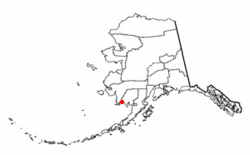Twin Hills, Alaska facts for kids
Quick facts for kids
Twin Hills, Alaska
Ingricuar
|
|
|---|---|

Location of Twin Hills, Alaska
|
|
| Country | United States |
| State | Alaska |
| Census Area | Dillingham |
| Area | |
| • Total | 23.04 sq mi (59.67 km2) |
| • Land | 22.90 sq mi (59.32 km2) |
| • Water | 0.14 sq mi (0.35 km2) |
| Elevation | 10 ft (3 m) |
| Population
(2020)
|
|
| • Total | 103 |
| • Density | 4.50/sq mi (1.74/km2) |
| Time zone | UTC-9 (Alaska (AKST)) |
| • Summer (DST) | UTC-8 (AKDT) |
| ZIP code |
99576
|
| Area code(s) | 907 |
| FIPS code | 02-79780 |
Twin Hills (which is Ingricuar in the local language) is a small community in Alaska, United States. It's called a census-designated place (CDP) because it's a special area used for counting people by the government. In 2020, about 103 people lived there.
Twin Hills was settled in 1965. However, the area where it is located today includes an older village called Togiak (or Togiagamute). This older village was on the northeast side of Togiak Bay. Many years ago, in the early 1900s, most people moved to the other side of the bay to start a "new" Togiak.
Where is Twin Hills Located?
Twin Hills is found in Dillingham Census Area, Alaska. It is located at the northeast end of Togiak Bay. It is also very close to the city of Togiak.
The total area of Twin Hills is about 59.7 square kilometers (23 square miles). Most of this area is land, about 59.0 square kilometers (22.9 square miles). A small part, about 0.7 square kilometers (0.14 square miles), is water.
Who Lives in Twin Hills?
| Historical population | |||
|---|---|---|---|
| Census | Pop. | %± | |
| 1880 | 276 | — | |
| 1890 | 94 | −65.9% | |
| 1970 | 67 | — | |
| 1980 | 70 | 4.5% | |
| 1990 | 66 | −5.7% | |
| 2000 | 69 | 4.5% | |
| 2010 | 74 | 7.2% | |
| 2020 | 103 | 39.2% | |
| U.S. Decennial Census | |||
The original village in this area, Togiagamute, was first counted in 1880. At that time, all the people living there were Inuit. By 1890, it was called "Togiagamiut," and all 94 residents were Native people.
After most people moved to the "new" Togiak, the area wasn't counted again for a long time. Then, in 1970, the new settlement of Twin Hills was established. In 1980, it officially became a census-designated place.
In 2000, there were 69 people living in Twin Hills. Most of the people were Native American (84.06%). Some were White (5.80%), and about 10.14% were from two or more races.
There were 24 households in 2000. About 37.5% of these households had children under 18 living with them. The average household had about 2.88 people.
The median age of people in Twin Hills in 2000 was 38 years old. About 36.2% of the population was under 18 years old.
Education in Twin Hills
Students in Twin Hills go to the Twin Hills School. This school is part of the Southwest Region School District.
See also
 In Spanish: Twin Hills (Alaska) para niños
In Spanish: Twin Hills (Alaska) para niños

